#PPG Indy Car World Series
Photo
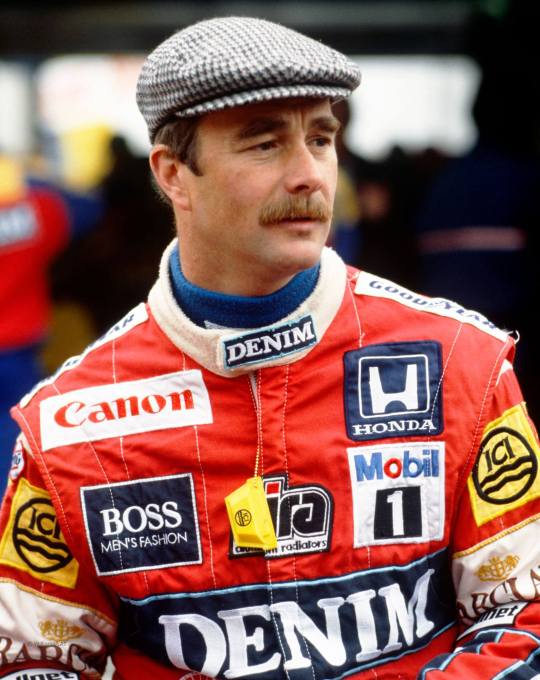
Nigel Mansell.
#formulaford#formula ford#britishformulathreechampionship#british formula three championship#europeanformulathreechampionship#european formula three championship#europeanformulatwochampionship#european formula two championship#formulaone#formula one#ppgindycarworldseries#ppg indy car world series#btcc#british touring car championship#fiagtchampionshipgt2#fia gt championship gt 2#grandprixmasters#grand prix masters#lemansseries#le mans series#24hoursoflemans#24 hours of le mans#uptonuponsevern#upton upon severn#worcestershire#motorracing#motor racing#nigelmansell#nigel mansell
4 notes
·
View notes
Photo
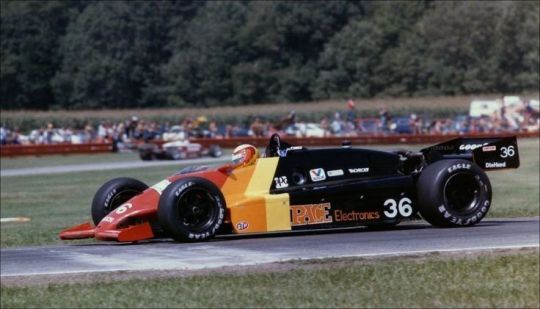
Dennis Firestone on his Lola T900 Cosworth at Mid Ohio Sports Car Course. 1985 PPG IndyCar World Series. 📷 imgur #indytuesday #tuesday . . . #indycar #indycarworldseries #aac #irl #indy #indy500 #openwheel #racing #racingcar #car #vintage #motorsport #motorsports #thundermotorsports #classicracing #classic #welcome #instagram #instagood #tumblr #facebook #gearhead #motor #petrolhead #petrolicious #midohio #midohiosportscarcourse (em Mid-Ohio Sports Car Course) https://www.instagram.com/p/Cgeu6NNLCWR/?igshid=NGJjMDIxMWI=
#indytuesday#tuesday#indycar#indycarworldseries#aac#irl#indy#indy500#openwheel#racing#racingcar#car#vintage#motorsport#motorsports#thundermotorsports#classicracing#classic#welcome#instagram#instagood#tumblr#facebook#gearhead#motor#petrolhead#petrolicious#midohio#midohiosportscarcourse
3 notes
·
View notes
Photo




Ferrari Mondial PPG Pace Car, 1988, by I.DE.A Institute. A one-off based on the Mondial built specifically as safety car for PPG Industries for the PPG Indy Car World Series
#Ferrari#Ferrari Mondial PPG Pace Car#I.DE.A Institute#mid-engine#1988#pace car#one-off#Indy Car World Series#PPG Indy Car World Series#1980s#design study#Ferrari Mondial
183 notes
·
View notes
Text
Movie Cars: The Wraith
The film The Wraith is a unique piece in our study of movie cars for a number of reasons:

One, it’s one of the lesser-known films. Following classics like Bullitt and Batman, The Wraith, a little film about a ghost taking revenge on the street-race gang that killed him is a smaller-scale film with an ensemble of cars that’s nothing to sneeze at: a Corvette Stingray, a ’66 Plymouth Barracuda, an ‘84 and an ‘87 Dodge Daytona, and a ’77 Pontiac Firebird Trans Am.
However, despite this impressive lineup of vehicles, the real main attraction of the film lies in the titular character’s vehicle: a ghost car portrayed by the Dodge M4S Turbo Interceptor, a pace car for the PPG-CART Indy Car World Series.
The Dodge M4S was originally built by Chrysler Corporation and PPG Industries, with the body design developed by Chrysler, and the finish (specially designed for the car) created by PPG Industries. Six copies of the car were produced in total; two of these copies were genuine stunt cars, made from molds of the original vehicle, with the other four merely ‘dummy’ cars, empty bodies on frames that were destroyed during production. The genuine article, the real Dodge M4S was used for close ups only.
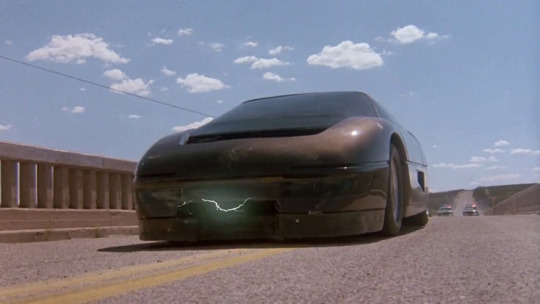
The Turbo Interceptor was a marvel in terms of technology, costing approximately $1.1 million to build, with performance well worth the price. The car was powered by a Chrysler 2.2 liter four-cylinder engine that exceeded 194 mph that made the car a one-of-a-kind standout among other famous cars in film history.
However, after all that, in the end, The Wraith, and the Dodge M4S, was largely forgotten. With no specifically interesting car chases, or anything else really to recommend it, The Wraith, not exactly a stellar stand-out, went mostly unnoticed in a decade full of other, more impressive films. The car was cool, sure, but unlike films like Bullitt, not even the Turbo Interceptor could raise this film above obscurity.
So, why discuss it here?
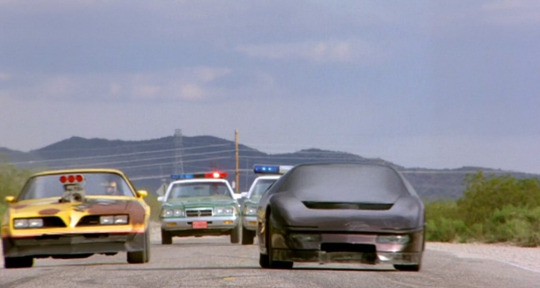
For one: the car is cool. The Dodge M4S was one of the more unique stand-outs in a string of iconic film vehicles, with a basic design that was memorable to those who watched it. However, as we’ve discussed before, what makes a film car memorable or not isn’t always just the design or power: it’s utilization.
In Bullitt, the main spotlight vehicle is interesting because it’s the protagonist’s vehicle, a car that participates in a thrilling chase scene. In Batman, it’s the Batmobile, for crying out loud. In The Wraith?
The major player of the film is a ghost-car, a vehicle that arrives only when a major set piece is about to take place: the harbinger of doom for the film’s antagonists. It isn’t just a vehicle, it’s a supernatural phenomenon, an indestructible machine that isn’t entirely physical.

There’s a mystery surrounding every time the titular Wraith makes an appearance, especially tying in the arrival of a newcomer into the town bearing suspicious scarring identical to the wounds of the deceased Jamie Hankins. Without adding any specific abilities to the car, already, something is special about it: it’s a ghost car with a mystery intact, belonging to a vengeful spirit that only appears when he’s ready to challenge someone else in a street-race to the death.
And in the end, that’s the car’s major claim to fame.
The Wraith is largely forgotten among film fans in general, and even movie car buffs for the most part, due to any number of reasons. However, the memorable aspect of the film isn’t solely the car itself: it’s the purpose within the narrative. The car in The Wraith is unique in its utilization within the story itself, not belonging to a hero in a chase, or driven with a side of pure ‘cool’ factor. Whenever this car makes an appearance in the film, it’s a sign that an Event is about to happen, that there’s going to be another death, to move the story along. This is no mere vehicle, it is a harbinger of doom, shorthand to the audience that something important is about to happen.

Unlike traditional race cars, chase cars, and cars outfitted with tons of gadgets, the car from The Wraith is simply an apparition, a tool of revenge used to street-race, equal parts eerie and impressive. And that’s what makes this particular vehicle a stand-out among other movie cars.
Are the race sequences groundbreaking in the way that the chase from Bullitt was? No.
Is the car as iconic as the Batmobile? No.
However, there is a level of iconography and cool factor about a haunted race-car that lends The Wraith a level of memorability that has stuck with it, even if only in a relatively small circle of fans that remember it. In the end, is it a classic cinematic car? Debatable. But it definitely is one worth checking out.
Thanks so much for reading, I hope to see you in the next article.
14 notes
·
View notes
Photo

A collection of cars barrel through the turn at Indianapolis.
CART PPG Indy Car World Series, Indianapolis Motor Speedway, 1981 Indianapolis 500
126 notes
·
View notes
Photo
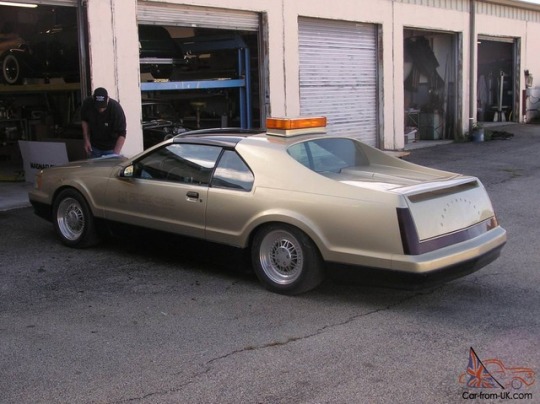
1984 Lincoln Mark VII PPG Indy Car, World Series Pace Car [1069 x 800] via http://autofan.xyz
3 notes
·
View notes
Text
Fast Cars: A 90s Film About IndyCar Featuring Willy T. Ribbs, Bobby Rahal, Lyn St. James, and Emerson Fittipaldi
Fast Cars: A 90s Film About IndyCar Featuring Willy T. Ribbs, Bobby Rahal, Lyn St. James, and Emerson Fittipaldi
This documentary starts out in late 1992 as Bobby Rahal and his team begin testing their new car – a car they hope will allow Rahal to win the championship and the Indy 500 in 1993.
The film features interviews with many of the sports leading lights including Willy T. Ribbs, Emerson Fittipaldi, Lyn St. James, and of course Bobby Rahal.
The 1993 PPG Indy Car World Seriesseason was sanctioned by…
View On WordPress
0 notes
Text
10 Italian-Themed Cars from the Annual Auto e Moto d’Epoca
The annual Auto e Moto d’Epoca (vintage cars and bikes) in Padua, Italy, is billed as the largest classic car market in Europe. It features 11 pavilions filled to the brim with vintage car dealers, clubs, manufacturers, an auction, as well as all manner of private sellers and vendors.
The cars themselves are spread across the expansive grounds, and with roughly 1,600 exhibitors and 5,000 cars on display, you’re never going to see it all. We put on our hiking shoes and explored the event to find 10 of the finest Italian and Italian-themed cars on display.
Lancia Delta Integrale ‘Safari Rally’
For rally enthusiasts, it doesn’t get much better than a Martini-liveried Lancia Delta. There were quite a few at the event and one of the best examples was displayed by the Lancia Heritage department. Still showing its battle scars, this was the very car driven to victory in the grueling Safari Rally in 1988 by Miki Biasion. It was Lancia’s ever first win in the event after 10 unsuccessful attempts.
Aston Martin DB4 GT ‘Continuation’
The past few years have seen several high-end manufacturers moving into new niche markets by building reproduction versions of their most iconic cars. Among them is Aston Martin, who kicked off its continuation program with a run of 25 DB4 GTs. The cars are built to the exact same specifications as the originals, which featured bodies by Touring of Milan. As the example at Auto e Moto proved, it is virtually impossible to distinguish the old from the new.
Porsche 356 Carrera Zagato
In a similar vein, Italian design house and coach builder Zagato has revived a design of the past in the form of a small run of nine Porsche 356 Carrera based coupes. The cars were built using drawings from 1959 of a car that may have been built but certainly has been lost. Accordingly, the intriguing project was dubbed the “Sanction Lost” project. All nine cars were quickly sold and the one here was shown on the Zagato Club stand.
Peugeot Tipo 3
Completed in 1892, this Peugeot features a German Daimler engine. Although it has no Italian components, this particular car was the very first ever registered for road use in Italy. Chassis No. 25 was ordered new by wealthy businessman Gaetano Rossi. He took delivery of the single cylinder engined machine on January 2, 1893, introducing the motor car to Italy. The rest, as they say, is history! Recently restored for the museum that owns it by Peugeot Italy, it is in fully functional condition.
March 90CA Alfa Romeo Indy
One of the European manufacturers to campaign in Indy car racing in the late 1980s was Alfa Romeo, who had turned its back on Formula 1 (it recently returned as an F1 sponsor). Considering the racing successes of the Italian manufacturer in the past, the Alfa Romeo V-8-engined Marches were highly anticipated. Unfortunately the expectations were never met, and after the 1990 season Alfa Romeo withdrew the effort. This is one of the three cars used during Alfa’s final year in the CART PPG Indy Car World Series.
Subaru Leone RX Turbo
One car we had originally walked by was this Subaru Leone RX Turbo. Prepared for rally racing, it was campaigned in the Ivory Coast and Safari rallies from 1982 to 1986 with little luck. But what piqued our Italian interest when we gave it a second look was that this car was the first ever Subaru delivered to Italy. The ex-Alessandro Molino Leone RX Turbo was beautifully presented with many mementos from its rally career.
Ferrari 250 GT Coupe
Headlining the Bonhams auction was a superb example of the Ferrari 250 GT Coupe. Built in the late 1950s, this understated but very attractive machine shared many components with Ferrari’s competition cars. This has also been its undoing as several of them were converted into replicas of the race cars. They are now collectibles in their own right as is underlined by the example on offer, which was estimated to sell for more than $600,000.
Etceterinis
During the 1950s there were a number of small Italian manufacturers building compact sports cars, usually powered by a Fiat-based four-cylinder engine. These are lovingly referred to as Etceterinis and there were a remarkable number of them on display. Some are more familiar like O.S.C.A. and Stanguellini but there were also rarer machines spread across the grounds including an Ermini and a Giannini. You see the nickname was well chosen!
Cisitalia 202 SC
When the Museum of Modern Art (MOMA) in New York held an exhibit featuring automobile design in 1951, one of the eight cars featured was the Cisitalia 202 SC Coupe. Its Pinin Farina-penned lines earned it a spot amongst much more prestigious and better known cars. The 202 SC is still part of MOMA’s permanent display but a sister car was shown with great pride here in Padua.
Abarth 207A
Austrian-born Carlo Abarth was a renowned engine tuner who primarily specialized in selling exhaust and intake kits designed to make standard cars go faster. He also dabbled in making cars of his own and the 207A Barchettas were among his first. Just 10 were built in 1955 and they featured a lovely body designed and built by Boano. Naturally, the Abarth exhaust system was prominently displayed on the right flank of the 207A. IFTTT
0 notes
Text
A Ridiculous, Unnecessary, Idiotic Comparison: Lebron James vs R.E.M.
Sunday night, Lebron James accomplished something that only select players from the legendary Boston Celtics teams of the 1960s can brag about – 8 consecutive appearances in the NBA Finals. As the King prepares for another turn on the game’s grandest stage, it’s worth taking a moment and looking back and what Lebron pulled off in the last 7 championships series. After all, doing anything at such a high level for 7 straight years should be celebrated.
But James isn’t the only all-time great to put together 7 consecutive years of excellence. In each year from 1982 to 1988, the band R.E.M. released a fantastic record, each of which contributed to their indelible legacy.
What does one have to do with the other? Nothing. But 7 straight years of Finals appearances versus 7 straight years of brilliant music begs for an answer to a question no one would ever ask: Which run was more impressive?
After all, if people can debate Lebron vs Jordan, why not Lebron vs R.E.M.?
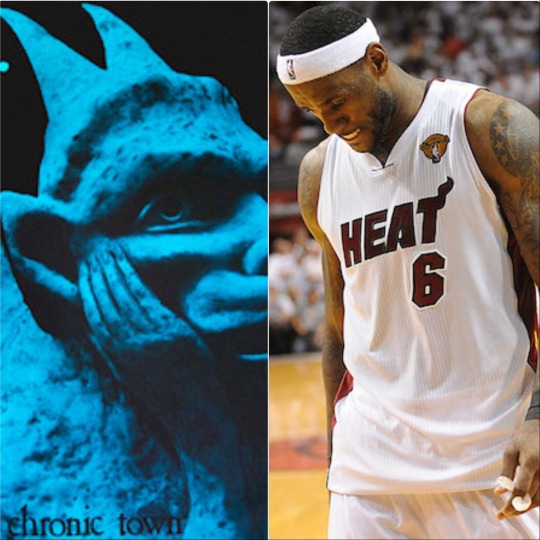
Year 1
Lebron James 2011
Lost to Mavericks (6 games)
Key Numbers: 17.8 PPG, 7.2 RPG, 6.8 APG
R.E.M. 1982
Chronic Town
Key Tracks: Carnival of Sorts (Box Cars), Wolves, Lower, Gardening at Night
Album lyric which could apply to Lebron: “We’ll stumble through the yard.” - Stumble
This one’s a slam dunk…sorry.
R.E.M.’s debut EP was set the standard for what was to come from one of the best American rock bands ever. Lebron’s first year with the Heat ended in a thud, with Dwyane Wade outplaying the King and Dallas winning Games 4-6 to capture its first title. No contest.
Verdict: R.E.M.

Year 2
Lebron James 2012
Won vs Thunder (5 games)
Key Numbers: 28.6 PPG, 10.2 RPG, 7.4 APG
R.E.M. 1983
Murmur
Key Tracks: Radio Free Europe, Catapult, Sitting Still
Album lyric which could apply to Lebron: “Not everyone can carry the weight of the world.” – Talk about the Passion
Everything came together for Lebron in the 2012 Finals. Taking the proverbial torch from Wade as the team’s clear leader, Lebron led the Heat in scoring in each game of the series, and finally captured that elusive 1st title, and 1st Finals MVP to boot. The first of many otherworldly performances for James on the game’s biggest stage.
But Murmur is awesome. And while Lebron would improve on that 2012 performance, R.E.M. never released a record as perfect as Murmur.
Verdict: R.E.M.
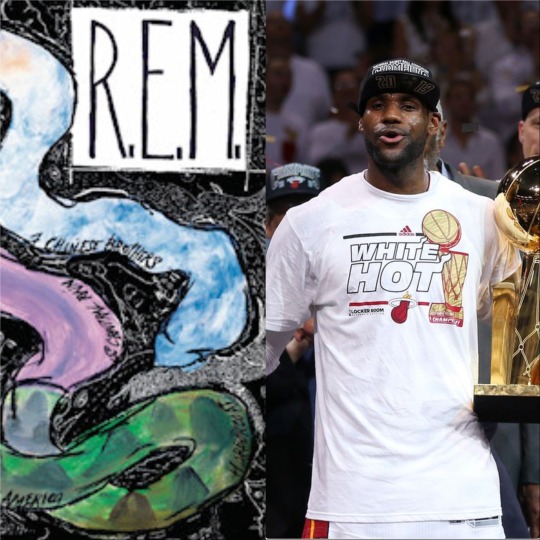
Year 3
Lebron James 2013
Won vs Spurs (7 games)
Key Numbers: 25.3 PPG, 10.9 RPG, 7 APG
R.E.M. 1984
Reckoning
Key Tracks: So. Central Rain, 7 Chinese Bros., (Don’t Go Back To) Rockville
Album lyric which could apply to Lebron: “Why are you trying to second guess me? I am tired of second guessing.” – Second Guessing
The most entertaining of Lebron’s 4 Finals appearances with Miami, the 2013 Finals may be best remembered for Ray Allen’s game tying shot in Game 6. But Lebron was the only player on either team to average over 20 points a game, en route to his 2nd straight Finals MVP and cementing him as one of the best to ever play the game.
R.E.M set impossible standards with Chronic Town and Murmur, and as a result, Reckoning – as great as it is – falls a little flat by comparison, despite the clear cut brilliance of So. Central Rain.
Verdict: Lebron James

Year 4
Lebron James 2014
Lost to Spurs (5 games)
Key Numbers: 28.2 PPG, 7.8 RPG, 4.0 APG
R.E.M. 1985
Fables of the Reconstruction/Reconstruction of the Fables
Key Tracks: Driver 8, Can’t Get There From Here, Feeling Gravitys Pull
Album lyric which could apply to Lebron: “Maybe he’s caught in the legend. Maybe he’s caught in the mood. Maybe these maps and legends have been misunderstood.” – Maps and Legends
Honestly, neither side deserves this one. Lebron’s last year in Miami sputtered out with a 5 game loss to San Antonio, despite gaudy personal numbers. Stories abound about the tension during the recording process for Fables, leading to R.E.M.’s worst record of the IRS era.
Still someone has to win, so because Lebron got out of Miami and returned home, he gets the edge.
Verdict: Lebron James
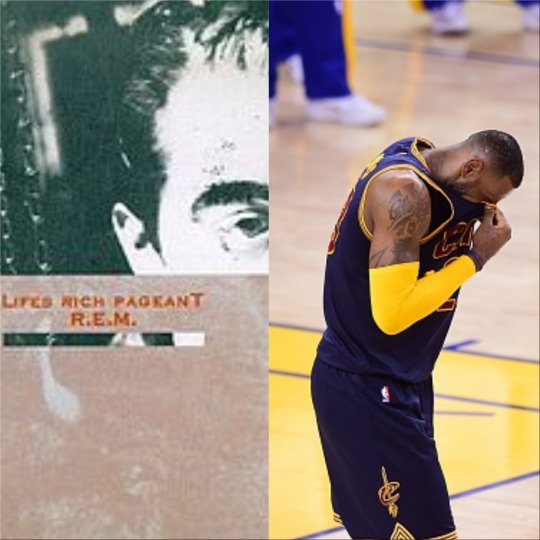
Year 5
Lebron James 2015
Lost to Warriors (6 games)
Key Numbers: 35.8 PPG, 13.3 RPG, 8.8 APG
R.E.M. 1986
Lifes Rich Pageant
Key Tracks: Fall on Me, Cuyahoga, Swan Swan H
Album lyric which could apply to Lebron: “I am, I am, I am Superman and I can do anything.” – Superman
What could have been in this series for Lebron. No Love, basically no Irving, and going up against a soon-to-be dynasty, and still puts up his best individual Finals performance.
But a loss is a loss, and Lifes Rich Pageant is anything but. Michael Stipe finds his voice and allows it to soar, delivering what may be a perfect song in “Fall on Me.”
Verdict: R.E.M.

Year 6
Lebron James 2016
Won vs Warriors (7 games)
Key Numbers: 29.7 PPG, 11.3 RPG, 8.9 APG
R.E.M. 1987
Document
Key Tracks: The One I Love, It’s the End of the World As We Know It (And I Feel Fine), Welcome to the Occupation
Album lyric which could apply to Lebron: “Your finest hour.” – Finest Worksong
Document is terrific, the result of a college rock band breaking through into the mainstream and delivering some of the band’s most iconic songs, ending their era as indie rock darlings and catapulting R.E.M. into the conversation of greatest American bands ever.
But Document didn’t come back from 3-1 down.
Document didn’t dethrone a 73-win team.
Document doesn’t have The Block.
Lebron’s defensive play against Andre Iguodala has already earned legendary status, and will only become more revered in time, particularly if Cleveland has to wait decades for another NBA title.
Verdict: Lebron James
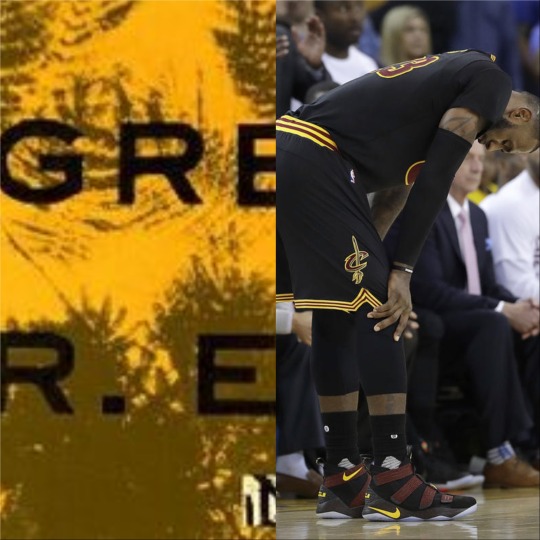
Year 7
Lebron James 2017
Lost to Warriors (5 games)
Key Numbers: 33.6 PPG, 12.0 RPG, 10.0 APG
R.E.M. 1988
Green
Key Tracks: World Leader Pretend, Pop Song ’89, Stand
Album lyric which could apply to Lebron: “The stars are the greatest thing you’ve ever seen and they’re there for you.” – You are the Everything
No one was beating the Warriors in 2017. But, bless his heart, Lebron tried. Averaging a triple-double in the Finals, James did everything he could to take down Golden State’s superteam, but it was task even the King couldn’t conquer.
Things were looking different for R.E.M. too. Green marked the band’s departure from I.R.S., ushering in a new era for the group on a major label. With the transition to Warner came a new direction in songwriting, creating new elements to their music which would become even more defined in their next 2 releases, Out of Time & Automatic for the People.
So how do you cast the deciding vote here? Lebron’s individual performance was incredible, but he ran into a superior opponent. R.E.M. created something great, but when compared to some of their earlier and later work, it’s not among the band’s elite recordings. What it comes down to for me is this: No one was stopping R.E.M. from releasing a great album year after year. For Lebron to fight through the grind year after year and return to the championship round is an accomplishment heretofore unseen. Add to it his 2018 performance dragging a subpar roster back to the Finals – and Lebron takes the crown for this ridiculous exercise.
Final Verdict: Lebron James
0 notes
Text
A ’69 Charger You’ll Either Love…or Love to Hate
The story of the 1969 Charger that (almost) every Mopar fan loves to hate.
Sacred ground. The automotive world is covered in it. And if you go by naked passion alone, there’s probably no real estate more precious than in Mopar land. There’s a two-by-three-foot patch on the ’68-to-’70 Charger that’s especially cherished, and Troy Gudgel at BBT Fabrications hates it. “I never understood why those lines crisscrossed,” he admits.
If you’re a Mopar freak you know what he’s talking about, and you’re probably tying a noose as we speak. If not, here’s why the lynching.
Each maker had a way to affect the Coke-bottle profile. Dodge’s designers extended the quarter-panel flare forward into a pair of false vents in each door, then it let the arc of the front fenders end just before crossing that flare. Ask people about it—more accurately, simply tell them that it even exists—and you’re likely to find more tolerance in a health-care reform bill, and that’s just a start.
Actually the start of the project is Vic Buraglio. “I had a ’69 Charger when it was new,” Vic begins. White, with green interior. Just like this one. “But it was just a 318 auto,” he’s quick to point out. And the car was special for other reasons. Among them, he and his wife got engaged and married when he had that car. “She gave me her ’64 Tempest and said, ‘I’m driving the Charger!’” he says, laughing.
“I said we could do it but there were some things that I wanted to change that are pretty iconic,” Troy continues. “So I told him, ‘Before I agree to do it 100 percent, I want to make sure you’re good with my ideas.’” Vic remembers hearing them. “I wasn’t too sold on it at first but then we got talking about body lines and everything.” Troy calculated his pitch. “We were working with [designer] Victor Fulton so I was able to show him what I was talking about,” he says. So Vic went for it.
Vic’s plans from the outset called for a perimeter frame, which Troy happily obliged. The Roadster Shop delivered a Fast Track chassis three inches longer in the wheelbase. The length solved another pet peeve. “I wanted to get rid of that big overhang up front,” Troy says. “And moving the front wheels forward did that.”
And that was really just the start. “I also didn’t like how high the ends of the car were,” he continues. “They just hang up there all high with all this space beneath them. So up front he brought the valance forward and down, making it more of a feature of the nose of the car. Pete Fortney did the same in the rear by dropping the quarters behind the wells by a couple inches. “That brings the ends of the car down and it also covers up the spare-tire well and gas tank,” Troy points out.
Troy and Pete also built aluminum bumpers for their respective ends and worked their way towards the center of the car. Now this is the point that may make some of you squeamish: They replaced the door skins with ones fabricated without the lines crossing. “They also don’t have those fake vents anymore,” Troy notes. He notes it somewhat gleefully, to be honest.
“We had to shape the top of the skins to go with the shape of the quarter panels and fenders,” he continues, explaining that they didn’t want to eliminate the car’s waisted, bottle-like profile (now that actually would be tragic). Turns out, reshaping those lines didn’t have profound effect elsewhere in the car. The lower crease in the rear quarter panel remains stock, but they did have to tweak the lower line behind the front well, and that was partly to patch the gap left by moving the wheel opening forward.
But this is more than a pretty face. “One of the other things we agreed upon is a Hemi,” Troy recalls. But the version in the car wasn’t his idea. “We put a Coyote in my last car,” Vic reveals, describing how modern power spoiled him. “It just goes. It doesn’t hesitate. Nobody’s gonna hit you in the ass at the stoplight. It just goes.”
Indy Cylinder Heads gave them a third-gen Hemi mill with a little more go than normal. It started with a 6.1 bottom end which Indy bored and stroked to 426 with a Compstar rotating assembly and Diamond pistons (it’s a 4.09-inch bore and 4.05-inch stroke in case you’re wondering). With otherwise stock 5.7 heads, the compression works out to a very pump-friendly 10.3:1. Dodge did a hell of a job with the SRT8 profile, so Indy kept it.
The result? The hybridized 426 made 499 lb-ft of torque and 451 hp. Now before you write off those numbers, it did peak torque at 4,200 rpm and made more than 400 until 5,700 rpm. And it made at least 400 hp from 4,200 rpm to almost 7,000 rpm (it was near 450 at 6,100 rpm). That’s a ton of power under the curve, which is really the measure of usefulness.
The real reason for Vic’s push for modern was the electronic engine management. Indy dispensed with the factory parts for an induction system made from Hilborn throttle bodies and an ECU from FAST. Paul Schaunmbacher modified a pair of Stainless Works headers made for a Ram pickup. He also made the 2 ½-inch exhaust out of stainless bends. It sports a set of Borla mufflers.
And it was that induction that developed the next part: the hood. Troy built it entirely from scratch and entirely from aluminum. And as you’d imagine, he dispensed with the false vents in it, too.
The reason actually ties in with the scoop. Yes, the Max Wedge thing predates the car, but it has a reason: it accommodates the injector stacks. So at the very least it’s functional, which is more than you can say about the vents that it replaced. Troy made it from scratch, too. Of course in aluminum—he just did it at a slightly smaller scale.
The hood mounts to a custom-fabricated hinge assembly which partly mounts to steel inner fender panels that Troy made. He also did the aluminum control-arm covers, the core-support cover, and the coolant and power-steering-fluid reservoirs embedded in it. Derek Bear painted the engine a dark bronze and everything around it the light gold. BBT shipped the project up to Dutch Boys Hot Rods in Kalamazoo, where it got a PPG DBU finish. “It’s some Audi color,” Troy says.
Clay Mitchem built the floor pans, wheel tubs, and driveshaft tunnel. The crew fabricated the remainder of interior panels from aluminum before delivering everything to Phil Cato at Cato’s Custom Upholstery. Though not obvious, the modifications are quite extensive. They replaced the blown-out stuffed-vinyl sections with heat-formed ABS. They made a panel specifically to fit a set of Dakota Digital VHX gauges.
Phil then dispensed with the seat springs and built up the profile from foam. “[Troy] picked out a few interior colors,” Vic remembered. “He was a little surprised when I told him it had to be green. ‘Green?’ he says. ‘I dunno about green.’” But some persuasion of his own convinced Troy. He laments the inability to find the stock color in leather but the straight green actually makes sense: America’s designers were paying attention to sports-car makers who were using greens like that at the time, just as they were doing the Coke-bottle profile more than a decade earlier.
“When we started talking wheels, I wanted to do something that was kind of period correct for a sixties muscle car,” Troy observes. “But I didn’t feel that there was anything out there that I wanted.”
Except one: “The wheel that kept popping into my head was the Sunburst wheel from the early AC Cobras,” Troy says. The only problem: Sunburst wheels only came in a 15 inch size, and nobody reproduces them. “So I talked [Jesse Greening] into making a set of one-offs,” Troy says.
Jesse made them in three pieces in 19×10 and 19×12. They mount to a set of pin-drive knock-off snouts bolted to the hubs. Diamondback Classics modified a set of 275/35ZR19 and 345/45ZR19 Bridgestone Potenzas to take a gold line.
Advanced Plating applied the nickel to those wheels’ rims, to the roll hoop, to the aluminum bumpers, and to the aluminum splitter bolted to the tail. “The car just needed something back there to balance the car,” Vic observes. Steve Hood created the profile from some inch-thick 3003-series stock, the same material as the bumpers, only thicker.
We’d like to think that some of this car’s biggest critics think a little better of it now, but that’s just fine if you don’t. Nothing good ever came from trying to please everyone. Make a statement and you’re bound to step on some toes.
But the response this car gets says something. People claim that BBT eliminated the thing that defines a ’68-to-’70 Charger: the door detail. Yet you’ll never hear anyone ask what kind of car it is—people still recognize it as a Charger.
So if a car is still recognizable after having its most definitive feature eliminated, is any of the ground around us so sacred after all? We sure hope not—you’d be out of a hobby and we’d be out of a job!
Builder Troy Gudgel found inspiration in Shelby Sunburst wheels. He had Victor Fulton scale them, then Greening Auto Company machine them. They’re pin-driven knock-offs and wear Bridgestone Pontenzas with yellow-wall inserts by Diamondback Classics.
Builder Troy Gudgel found inspiration in Shelby Sunburst wheels. He had Victor Fulton scale them, then Greening Auto Company machine them. They’re pin-driven knock-offs and wear Bridgestone Pontenzas with yellow-wall inserts by Diamondback Classics.
Historically speaking, a Max Wedge scoop is a little out of place. But on a design mash-up, they’re great. And as a means to give the Hilborn stacks clearance, they’re perfect. Troy built the hood without the false vents, another element he dislikes.
Indy Cylinder Heads stepped up with a 6.1L bottom-end that it bored and stroked to 426 cubes, then topped with 5.7 heads. Its 499 lb-ft and 450 hp output seems a touch shy, until you see its Kansas-flat power curve.
Here’s what all the fuss is about: door skins. Oddly enough, Troy and Pete didn’t need to touch the quarters, and the only reason they modified the fenders was to fill the gap opened up by moving the wheels forward.
BBT made the dash almost entirely from ABS and aluminum to mount Dakota Digital VHX gauges. Troy also built the steering-wheel center entirely before sending it to Phil Cato for trimming.
The seats merely look vintage; Phil Cato replaced the springs with several densities of foam chosen and shaped for each part of the seat. Relicate supplied the leather.
Though originally a unit-construction car, the Charger now has its own tubular chassis. Roadster Shop made it three inches longer to move the front wheels forward, which reduced the front overhang—something that many cars can benefit from.
Steve Hood machined the splitter from inch-thick aluminum bar stock. Troy and Pete made the bumpers for their respective ends from the same material, only 1/8-inch thick. They also made the roll pans, albeit from steel and a couple inches deeper than stock.
The post A ’69 Charger You’ll Either Love…or Love to Hate appeared first on Hot Rod Network.
from Hot Rod Network http://www.hotrod.com/articles/1969-charger-love-or-hate/
via IFTTT
0 notes
Photo
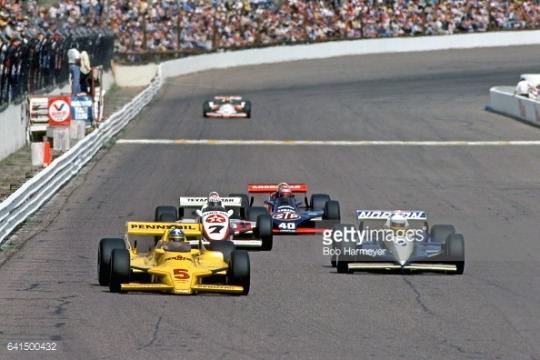
02-12 AVONDALE, AZ - March 28: Johnny Rutherford leads a group of cars in the Jim Hall Chaparral 2K/Cosworth during the Kraco Car Stereo 150 CART PPG Indy Car World Series race on March 28, 1982, ... http://dlvr.it/NMBPwN
0 notes
Photo
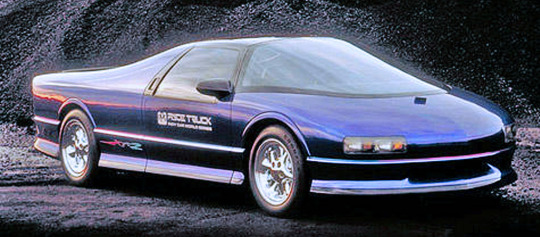
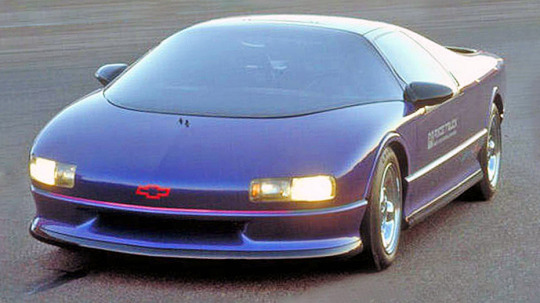

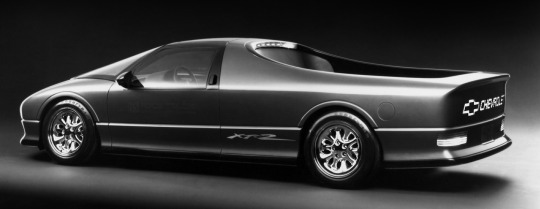
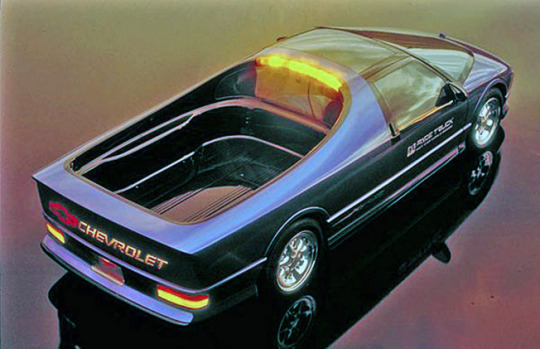
Chevrolet PPG XT-2 Pace Truck, 1989. A concept pick-up truck (XT = Experimental Truck) featuring Corvette-derived suspension and a 4.5 litre 360hp V6. It was used as a CART PPG Indy Car World series pace truck
#Chevrolet#Chevrolet XT-2#concept#concept pick-up#pick-up#pick-up truck#1989#pace car#pace truck#V6#prototype#design study
1K notes
·
View notes
Photo

Mario Andretti (#6) gets a nose underneath Nigel Mansell (#5) at Michigan.
CART PPG Indy Car World Series, Michigan International Speedway, 1993 Marlboro 500
#cart#indycar#champ car#michigan#michigan international speedway#1993#marlboro 500#mario andretti#nigel mansell#racing#motorsport
54 notes
·
View notes
Photo
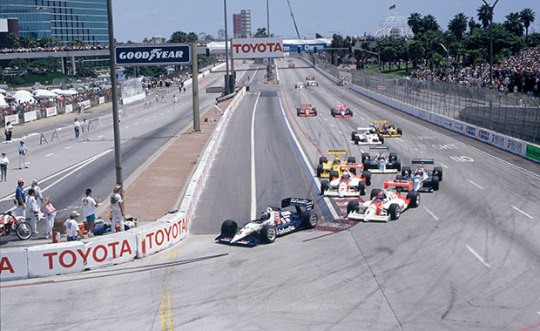
Al Unser, Jr. (#5) dives it into the turn ahead of several cars at Long Beach.
CART PPG Indy Car World Series, Long Beach Street Circuit, 1990 Toyota Grand Prix of Long Beach
#cart#indycar#champ car#long beach#long beach street circuit#long beach grand prix#1990#al unser jr#racing#motorsport
38 notes
·
View notes
Photo

Danny Sullivan (#4) leads Bobby Rahal (#3) through the corkscrew at Laguna Seca.
CART PPG Indy Car World Series, Laguna Seca Raceway, 1985 Stroh’s 300k
#cart#indycar#champ car#laguna seca#laguna seca raceway#stroh's 300k#1985#danny sullivan#bobby rahal#racing#motorsport
47 notes
·
View notes
Photo

Johnny Rutherford (#4) and Mario Andretti (#12) pace under the parade lap preceding the start at Phoenix.
CART PPG Indy Car World Series, Phoenix International Raceway, 1980 Miller High Life 150
#cart#indycar#champ car#phoenix#phoenix international raceway#miller high life 150#1980#johnny rutherford#mario andretti#racing#motorsport
48 notes
·
View notes